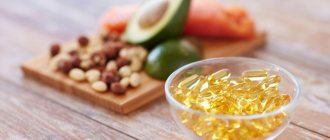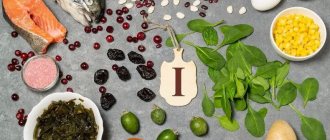December 18, 2021 October 26, 2021
The evidence for the benefits of omega-3 fatty acids is growing every year. Thus, recently, employees of the Faculty of Pharmacy at the University of the Basque Country discovered that omega-3 PUFAs can help with Parkinson’s disease 1, and a team of scientists from Korean universities has proven the effectiveness of acids of this class in the prevention of gastrointestinal cancer 2.
Where can a person get these important substances, what products contain them, and do they all have the same value?
What omega-3-PUFAs are there?
Today there are 11 known omega-3 polyunsaturated fatty acids. 3 of them are indispensable for humans. The remaining 8 are found in food and may have biological effects, but do not play a major role.
The three important omega-3 PUFAs have their own gradation. The simplest of these is alpha-linolenic acid (ALA). In itself, it is not of fundamental importance for health. Its main advantage is that from it the human body is able to synthesize two other omega-3-polyunsaturated fatty acids: eicosapentaenoic acid (EPA) and docosahexaenoic acid (DHA). The processing efficiency is extremely low: on average, only about 5% of ALA is converted into EPA and 0.5% into DHA.
It is EPA and DHA that give omega-3 polyunsaturated fatty acids their health benefits. This reduces the risk of cardiovascular diseases, helps with depression, and has a positive effect on vision. The recommended intake of these acids for an adult is 2 g per day.
An article about why omega-3 PUFAs are especially important for women.
Thus, the question “What do omega 3-PUFAs contain?” it is appropriate to consider separately for each of the three significant acids: ALA, EPA and DHA.
Anti-inflammatory effect
One of the main properties of Omega-3 is its anti-inflammatory effect. Chronic inflammatory processes in the body pose a danger, including the development of malignant neoplasms. The anti-inflammatory effect of Omega-3 is due to the fact that they form hormone-like substances prostaglandins, which suppress inflammatory reactions and are of great importance for the functioning of our immune system. Omega-3 acids reduce inflammation in the joints, including the joints of the spine, and help with rheumatoid arthritis. By suppressing inflammatory processes in the gastrointestinal tract, Omega-3s are a good anti-ulcer agent.
What foods contain the omega-3 PUFA alpha-linoleic acid?
There are a number of plant foods that contain large amounts of ALA. These are nuts (especially walnuts), soy, flax and chia seeds. The ALA concentration in Brussels sprouts is slightly lower, but this vegetable is easily accessible and well suited for the daily diet. In addition to ALA, the foods listed are rich in fiber and minerals.
Some types of vegetable oils can also boast high levels of ALA: flaxseed, mustard, perilla. They should be used when preparing cold dishes, for example, added to salads or sauces. When heated, omega-3 PUFAs are destroyed, so frying in such vegetable oils is not recommended.
However, due to the low efficiency of converting ALA into EPA and DHA, these products are not able to provide the recommended daily intake of omega-3 PUFAs. Walnuts, flaxseed and others can only be considered as an addition to the diet.
Functions in the human body
Omega-3s literally help maintain and increase health, as they:
- They take part in the synthesis of eicosanoids (tissue hormones), which regulate intracellular metabolism.
- Reduce the risk of heart attack and stroke by lowering blood cholesterol levels.
- They are an important component of the tissues of the nervous system.
- Take part in the formation of sperm.
- They regulate the production of many hormones, including testosterone.
- They help cope with psycho-emotional overloads and prevent the development of depressive states.
- They prevent the occurrence of allergies and the development of autoimmune processes due to their anti-inflammatory properties.
- Improves memory and attention.
- Have a beneficial effect on the condition of the skin.
- Reduces the level of stress hormone cortisol.
In addition to all of the above, omega-3s are needed by everyone who wants to lose weight and is actively involved in sports: they promote fat burning and help build lean muscle mass. Fatty acids of this class are also useful for patients with chronic arthritis and arthrosis, as they improve the elasticity of joints.
Which foods contain omega-3 PUFAs eicosapentaenoic and docosahexaenoic acids?
EPA and DHA go hand in hand and are found in the same foods. These are seafood: fish and their caviar, shellfish. It is curious that the fish itself does not synthesize omega-3 PUFAs, but obtains them from underwater vegetation. We can do the same by eating seaweed that is edible for humans - for example, chuka or seaweed.
If you consume a portion of mackerel, salmon, herring, oysters several times a week, you can completely solve the problem of a lack of omega-3 PUFAs in the body. Seafood is also rich in selenium and B vitamins.
Omega fatty acid dossier
Omegas are polyunsaturated fatty acids. They give the cell flexibility so that it can allow hormones, vitamins and minerals to pass through.
There are about 30 different polyunsaturated fatty acids. They are combined into 3 Omega groups: 3, 6 and 9. Their main difference from each other is their chemical composition and form. This affects their functions in the body.
Omega-3
The most necessary for the body. Most often we miss it. The body does not produce it itself. Its level depends on what we eat.
Benefits of Omega-3:
- supports vascular and heart health by increasing “good” HDL cholesterol and decreasing “bad” LDL cholesterol
- maintains skin elasticity and beauty
- reduces inflammation
- accelerates muscle recovery
- increases energy
- reduces anger
- improves mood and memory
- increases the sensitivity of cells to insulin, thereby stabilizing blood sugar levels
- stimulates the immune system. Omega-3 is part of the protective layer of the cell against the invasion of viruses, increases the activity of T cells and macrophages - the main fighters against infections.
Omega-6
We consume it even more than we need. Just like Omega-3, we need it for a healthy heart and blood vessels. When there is an excess of it, the elasticity of the cell membrane rapidly decreases, it hardens, which is why it gradually collapses. This can lead to the formation of blood clots and narrowing of blood vessels. In addition, excess Omega-6 increases inflammation.
Omega-9
It comes not only from food, but is also produced in the body. Thanks to it, blood vessels and skin maintain elasticity and youth. It also reduces inflammation, increases energy, reduces anger and improves mood. More often than not, this Omega is enough for us. After all, if we don’t eat enough of it, our body comes to the rescue and produces as much as it needs.
Omega Sources
Omega-3 - fatty fish, especially mackerel, sardine, herring, coho salmon, chinook salmon, chum salmon, pink salmon, sockeye salmon, salmon, anchovies; seaweed, fish oil, camelina, flaxseed, rapeseed oils, flax seeds, chia and walnuts.
Omega-6 - sunflower, palm, grape oils, tofu, seeds, peanuts, almonds, cashews, sesame.
Omega-9 - olives, avocados, olive oil, pistachios, hazelnuts, cashews, Brazil nuts, almonds.
What to do to ensure you have enough Omega-3 every day
The daily intake of Omega-3 is 500 mg.
To get it, you need to eat at least 25 grams of mackerel or 40 grams of herring. Eating this way every day can be problematic.
It is more logical to eat fish 2 times a week, for example, once you eat a 200 gram portion of chum salmon, and the second time - a 250 gram portion of pink salmon. In total, you get your weekly Omega-3 intake.
Supplement your lunch with 30 grams of walnuts, season the salad with flaxseed or camelina oil.
These foods will not only help maintain your Omega-3 levels. These are excellent sources of calcium, phosphorus, vitamin D and easily digestible protein.
Make it a habit to eat oily fish 2 times a week. If you haven't eaten it in a particular week, just take a few Omega-3 capsules.
Why Lab4U does not recommend taking Omega 6
It is not easy to eat fish every day or at least 2 times a week. Therefore, many people lack Omega-3. At the same time, we receive Omega-6 in excess every day.
Our task: increase Omega-3 and reduce Omega-6 consumption.
When you get too much Omega-6, Omega-3 is poorly absorbed. This occurs due to competition for enzymes, whose task is to sort Omega into shelves and deliver it to cells.
It is good for the body when the ratio of Omega-3 to Omega-6 is no more than 1 to 4.
If the ratio is higher, the risks of cancer, asthma, autoimmune diseases, obesity, depression, ischemia, cellular damage and early aging increase. Cells will begin to transmit electrical signals more slowly and you will begin to freeze, like Windows XP. Words are more difficult to choose, movements and reactions slow down.
If, according to test results, the ratio of Omega-6 to Omega-3 is more than 4 to 1, for example, 6 to 1, review your diet, add fatty fish to your diet, Omega-3 supplements, replace sunflower oil with flaxseed, camelina or olive oil, they contain less Omega-6.
Table of Omega-3 acids content in 3 products
Data on the amount of essential omega-3 PUFAs in popular foods are shown in the table.
| Product | What acid does it contain? | Content per 100 g of product, mg | Additionally |
| Mackerel | EPA+DHA | 5 134 | 100 g of mackerel contains 200% of the daily value of vitamin B12 and 100% of selenium |
| Salmon | EPA+DHA | 2 260 | Contains high-quality protein, large amounts of magnesium, potassium, selenium and B vitamins |
| Herring | EPA+DHA | 1 729 | 100 g of herring contains 400% of the daily value of vitamin D, 200% of vitamin B12 and 50% of selenium |
| Oysters | EPA+DHA | 672 | Oysters contain more zinc than any other food - 600% of the daily value per 100 g, as well as 200% copper and 300% vitamin B12 |
| Sardines | EPA+DHA | 1 480 | 100 g of sardines contain 150% of the daily value of vitamin B12 and 75% of selenium |
| Tuna | EPA+DHA | 1 664 | 100 g of tuna contains 180% of the daily value of vitamin B12 and 65% of selenium |
| Anchovies | EPA+DHA | 2 113 | Product rich in vitamin B3, selenium and calcium |
| Red and black caviar | EPA+DHA | 6 789 | High content of vitamins B4 and B12 |
| Flax-seed | ALC | 2 2813 | Very rich in fiber, vitamin E, magnesium |
| Chia seeds | ALC | 17 552 | High level of minerals: calcium, manganese, phosphorus |
| Walnuts | ALC | 9 079 | Contains a lot of fiber, copper, manganese, vitamin E |
| Soya beans | ALC | 1 443 | Source of potassium, magnesium and vitamins B2, B9, K |
| Brussels sprouts | ALC | 173 | Source of vitamins C and K |
Daily norm. How to take omega-3?
There are no generally accepted strict recommendations for daily intake of omega-3. And the opinions of experts from various medical organizations vary significantly. But I compiled a table based on the recommended average values for different groups of people.
| Age category | Recommended dosage, mg |
| Children under 1 year | 500 mg |
| Children from 1 year to 3 years | 700 mg |
| Children from 4 to 8 years old | 900 mg |
| Children from 9 to 13 years old | 1000 - 1200 mg |
| Teenagers from 14 to 18 years old | 1200 – 1600 mg |
| Adults from 18 to 59 years old | 1000 – 1600 mg |
| Over the age of 60 | 1600 – 2000 mg |
| Pregnant | 1400 - 1800 mg |
| During lactation | 2000 – 2500 mg |
| During active sports | 3000 – 3500 mg |
It should be taken into account that various diseases may require taking more fatty acids. In this case, you need to undergo the necessary tests and consult with doctors.
Taking omega-3 supplements on a regular basis is not recommended. An excess of fatty acids can also negatively affect the body, just like a deficiency. Medical experts recommend taking omega-3 three times a year. The duration of the course should be 30 days, then take a break for 60 days.
Omega-3 food supplements
If the diet is low in fatty acids, then adults and children are advised to take pharmaceutical food supplements that include omega-3. These supplements are usually sold in capsule form. At the pharmacy you can ask for fish oil, flaxseed oil, as well as vitamins and medications, including EPA, DHA and ALA.
These drugs are good sources of omega-3 for people who are predisposed to hypertension, stroke, and heart attack. Medicines are also prescribed to improve the condition of patients suffering from lupus erythematosus, arthritis, depression, and scleroderma.
With proper and nutritious nutrition, it is impossible to encounter a pronounced deficiency of polyunsaturated acids. It should be borne in mind that omega-3 acids from food are absorbed better than from pharmaceuticals. Therefore, every person should daily enrich their menu with animal and plant products saturated with fatty acids.
World's Healthiest Foods Ranking of Foods Sources of Omega-3 Fatty Acids
| Product | Serving Size | Calories | Quantity (g) | DN (%) | Saturation | WHF rating |
| Ground flax seeds | 2 tbsp. l. | 74.8 | 3.19 | 132.9 | 32.0 | Great |
| Walnuts | 0.25 cups | 163.5 | 2.27 | 94.6 | 10.4 | Great |
| Salmon | 100 g | 244.9 | 1.47 | 61.2 | 4.5 | Very good |
| Sardines | 85 g | 188.7 | 1.34 | 55.8 | 5.3 | Very good |
| Beef, eco | 100 g | 175.0 | 1.10 | 45.8 | 4.7 | Very good |
| Carnation | 2 tsp. | 13.6 | 0.18 | 7.5 | 9.9 | Very good |
| Soya beans | 1 cup boiled | 297.6 | 1.03 | 42.9 | 2.6 | Fine |
| Halibut | 100 g | 158.8 | 0.62 | 25.8 | 2.9 | Fine |
| Scallops | 100 g | 127.0 | 0.41 | 17.1 | 2.4 | Fine |
| Shrimps | 100 g | 112.3 | 0.37 | 15.4 | 2.5 | Fine |
| Tofu | 100 g | 86.2 | 0.36 | 15.0 | 3.1 | Fine |
| Tuna | 100 g | 157.6 | 0.33 | 13.8 | 1.6 | Fine |
| Cod | 100 g | 119.1 | 0.32 | 13.3 | 2.0 | Fine |
| winter pumpkin | 1 cup baked | 75.8 | 0.19 | 7.9 | 1.9 | Fine |
| Leafy greens | 1 cup ready | 49.4 | 0.18 | 7.5 | 2.7 | Fine |
| Spinach | 1 cup ready | 41.4 | 0.17 | 7.1 | 3.1 | Fine |
| Raspberries | 1 cup | 64.0 | 0.15 | 6.2 | 1.8 | Fine |
| Cabbage | 1 cup ready | 36.4 | 0.13 | 5.4 | 2.7 | Fine |
| Mustard seeds | 2 tsp. | 20.3 | 0.11 | 4.6 | 4.1 | Fine |
| Romaine lettuce | 2 cups | 16.0 | 0.11 | 4.6 | 5.2 | Fine |
| Turnip | 1 cup ready | 28.8 | 0.09 | 3.8 | 2.3 | Fine |
| Strawberry | 1 cup | 46.1 | 0.09 | 3.8 | 1.5 | Fine |
| Brussels sprouts | 1 cup raw | 37.8 | 0.09 | 3.8 | 1.8 | Fine |
| Miso | 1 tbsp. | 34.2 | 0.08 | 3.3 | 1.8 | Fine |
| Green beans | 1 cup raw | 31.0 | 0.07 | 2.9 | 1.7 | Fine |
| Pumpkin | 1 cup raw | 18.1 | 0.06 | 2.5 | 2.5 | Fine |
Interaction with other vitamins
There are many vitamins and minerals available, but I tested the omega-3 essential ones, which are the most important for the body and are most often taken in supplement form. The compatibility level of the elements is indicated in the left column. If you need to take vitamins that are not compatible with omega-3s, take them at different times of the day (for example, morning and evening).
| Compatibility | Nutrients |
| High | E, K, B2, B6, B9 (folic acid), B12, coenzyme Q10, lecithin |
| Neutral | A, B1, B3, B5, C, D, K, magnesium, zinc, selenium |
| Low | B7 (biotin), calcium, iron, copper, chromium |
You should not drink alcohol while taking omega-3. Drinking alcohol destroys liver enzymes involved in the breakdown of polyunsaturated fatty acids.
Use foods rich in vitamins; give preference to minimally processed vegetables. A variety of salads with added vegetable oils and seeds will reduce your need for fatty acids. Be sure to get tested regularly to monitor your vitamin levels and keep up with the supplements you need for your health and wellness.
What should you pay attention to when choosing the right Omega?
Raw material quality
There are two types of fish raw materials: from the back (carcass) of fish (Fish body oil) or from fish liver (Fish liver oil). It is not recommended to choose fish liver oil as a raw material, since toxic substances can accumulate in the liver that cannot be completely removed by filtration.
Compound
- The percentage of EPA/DHA should be at least 60%.
- The quantitative ratio of EPA/DHA acids is also important; 2:1 is considered the most effective.
- According to WHO recommendations, the daily requirement for Omega-3 is from 500 to 1000 mg.
Presented form
Manufacturers produce Omega-3-based drugs in three forms:
- Natural triglycerides
are the form that occurs in nature. In our body it undergoes complete and rapid metabolism, that is, it is completely absorbed. The concentration of Omega-3 in them is small, and such fractions do not undergo a thorough degree of purification to remove heavy metal impurities. Omega-3 in liquid form is always, as a rule, represented by triglycerides. TG marking. - Ethyl esters
are a synthesized substance, the result of industrial processing of fish oil with ethyl alcohol in order to obtain a high concentration of Omega-3 in it and remove toxins. This form is safer than TG, but is less absorbed. Marking EE, ethyl esters. - Reesterified triglycerides
. This form is resistant to oxidation. The processed raw materials are quickly digested and retain up to 90% of fatty acids. rTG marking - Phospholipids
. This is by far the most expensive form obtained from krill oil. It has the highest concentration of Omega-3, is quickly metabolized and is almost completely absorbed. Another significant advantage of this form is its content of astaxanthins, powerful antioxidants. Safe for pregnant women, as shellfish do not accumulate mercury. Ph marking
Omega 3-6-9 Super, 45 capsules, Evalar
750 ₽
Dietary supplement NOT A MEDICINE
Degree of purification
Fish tend to accumulate heavy metals in their bodies, and the larger the fish, the more toxins it contains. The pharmaceutical industry has GMP and GOED quality and safety standards that guarantee a high degree of purification.
Omega-3 intake by children and pregnant women
As a result of scientific research, it has been established that the mother’s body daily releases about 2.5 grams of polyunsaturated acids to the body of the child developing in the womb. Therefore, pregnant women are recommended to include fish or seafood and vegetable oils in their menu every day.
For the proper development of the body, it is useful for young children to take dietary supplements based on fish oil or vegetable oils. However, the child's intake of medications should be carried out under the supervision of parents or a pediatrician to prevent overdose.











